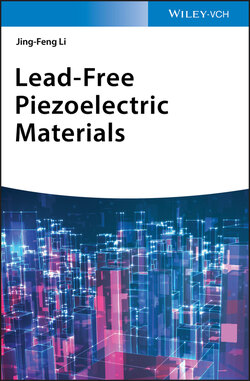Читать книгу Lead-Free Piezoelectric Materials - Jing-Feng Li - Страница 13
1 Fundamentals of Piezoelectricity 1.1 Introduction
ОглавлениеIn 1880, Pierre Curie and Jacques Curie discovered the (direct) piezoelectric effect in quartz (SiO2) and other single crystals, which generates an electric charge proportional to a mechanical stress. The converse piezoelectric effect, a geometric strain proportional to an applied voltage, was also soon realized. Since then, quartz has been one of the most well‐known and widely used piezoelectric materials. Many decades later, polycrystalline piezoelectric ceramics (oxides) have been discovered. The first one is BaTiO3 that was discovered during the World War II, which was used as dielectric materials for solid condensers at first [1]. In 1947, Roberts found that BaTiO3 ceramics (polycrystals) showed good piezoelectricity, about 100 times higher than that of quartz, after they were poled under a high voltage [2]. Since then, BaTiO3 ceramics have been widely applied to transducers, sensors, and filters, particularly in Japan. In 1952, Shirane et al., reported that solid solutions can be formed between PbTiO3 and PbZrO3 [3, 4]. One year later, ferroelectricity and antiferroelectricity were found in the solid solutions [5]. In 1954, Jaffe et al. studied the piezoelectric properties of PbTiO3–PbZrO3 solid solution ceramics, and found that its piezoelectric constants were twice as high as that of BaTiO3, and its Curie temperature (above which the piezoelectricity disappears) was over 300 °C [6]. Now, the PbTiO3–PbZrO3 solid solutions, abbreviated as PZT, are the most widely used piezoelectric ceramics [7–10]. The PZT ceramics show greatly enhanced piezoelectric and dielectric properties when the Zr/Ti ratio is close to 52/48, where exists a morphotropic phase boundary (MPB) separating the rhombohedral and tetragonal regions [7]. It is generally understood that the piezoelectricity enhancement stems from the effect of phase coexistence enabled by the existence of MPB.
Despite the facts that BaTiO3 is lead‐free and was also discovered before PZT, the markets of piezoceramic applications have been dominated by PZT‐based ceramics mainly because of its following advantages compared with BaTiO3: (i) excellent and adjustable piezoelectric properties, (ii) relatively high Curie temperature, and (iii) relatively low sintering temperature. Recently, environmental protection has become a major global concern, and environmental‐friendly materials and technology are one of the main tasks to be resolved in this new century. The manufacturing, handling, and disposal of PZT ceramics, which contain >60 wt% of lead, pose harmful influences on the workers' safety and soil environment as well as water supply. That is why many countries have incentivized the development of lead‐free piezoelectric materials [11–18].
For the R&D of lead‐free piezoelectric materials, it is very important to get a full understanding of piezoelectric principles and the piezoelectric mechanisms of existing piezoelectric materials, especially PZT ceramics. However, because PZT ceramics have many important applications, and in some sense, its application research has moved faster compared with the fundamental research on its piezoelectric mechanism, there are still a lot of things remaining very unclear. For example, the phase diagram of PZT around the MPB has been renewed even after half a century passed since the discovery of PZT [19–21], and rigorous descriptions still lack for unambiguous understanding of the MPB's contribution to piezoelectricity. The fundamental structure–property mechanisms revealed in lead‐containing piezoelectric materials can be also operational in lead‐free systems and at a minimum, should be considered as starting guidelines for the development of lead‐free piezoelectrics from the aspects of composition modification, microstructure tailoring, property characterizations, device applications, etc.
